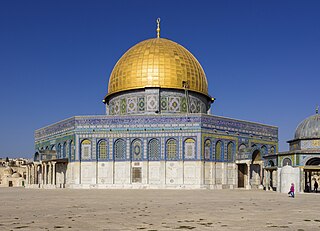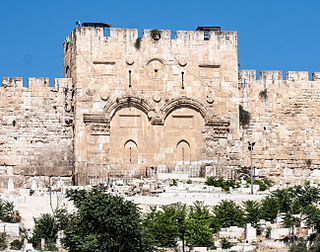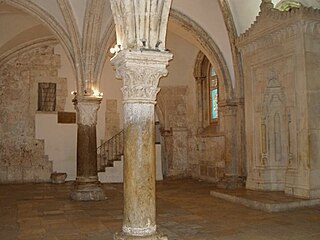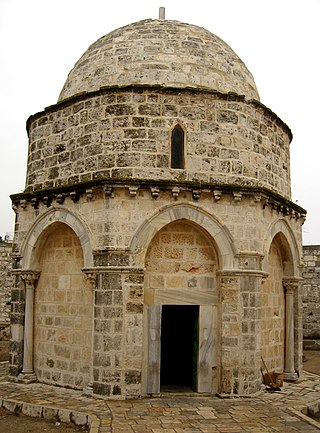
The Mount of Olives Hotel, located next to the Church of the Ascension on the summit of the Mount of Olives, is an ancient hostelry in Jerusalem.

The Mount of Olives Hotel, located next to the Church of the Ascension on the summit of the Mount of Olives, is an ancient hostelry in Jerusalem.
The Church of the Ascension was originally constructed by a Roman noblewoman named Poimenia around AD 390. The adjoining hostelry was built by two Western Christians: Rufinus and Melania, an aristocratic lady of Spanish descent. This first structure was destroyed by the Persians in 614, but replaced by St Modestus shortly thereafter. Around 1150 the establishment was rebuilt under the orders of Bernard de Tremelay, Grand Master of the Knights Templar, and remained a Templar possession until taken over by the Muslims under Saladin in 1187. It has been in Muslim hands ever since, though has always catered mainly for Christian visitors.
Part of the basement of the Templar structure currently serves as the Internet room for hotel guests, [1] and can also be rented out as a meeting room. One of the oldest surviving Baphomet carvings can be seen above the door of the hotel kitchen, at the far end[ citation needed ]. The rest of the building was renovated in 1960 by its owners, the Khweis family, and replaced with a much larger modern construction.
The hotel has 54 rooms, 11 of which offer a view of Jerusalem from the highest vantage point in the city. [2] In addition to the Church of the Ascension, which adjoins the hotel to the south, the Garden of Gethsemane is approximately a ten-minute walk away to the west, down the steep slope of the Dominus Flevit ("Jesus Wept"). The Old City of Jerusalem is a further ten minutes away (across the busy modern Jericho ring road, which runs through the Kidron Valley), and is entered through the Lions' Gate (St Stephen's Gate) and the Via Dolorosa. Many other Jewish, Christian and Muslim holy sites are also in the vicinity.
The hotel is owned by Ibrahim Dawud. [3]

The Temple in Jerusalem, or alternatively the Holy Temple, refers to the two religious structures that served as the central places of worship for Israelites and Jews on the modern-day Temple Mount in the Old City of Jerusalem. According to the Hebrew Bible, the First Temple was built in the 10th century BCE, during the reign of Solomon over the United Kingdom of Israel. It stood until c. 587 BCE, when it was destroyed during the Babylonian siege of Jerusalem. Almost a century later, the First Temple was replaced by the Second Temple, which was built after the Neo-Babylonian Empire was conquered by the Achaemenid Persian Empire. While the Second Temple stood for a longer period of time than the First Temple, it was likewise destroyed during the Roman siege of Jerusalem in 70 CE.

The Temple Mount, also known as Haram al-Sharif, al-Aqsa Mosque compound, or simply al-Aqsa, and sometimes as Jerusalem's holyesplanade, is a hill in the Old City of Jerusalem that has been venerated as a holy site for thousands of years, including in Judaism, Christianity and Islam.

The Dome of the Rock is an Islamic shrine at the center of the Al-Aqsa mosque compound on the Temple Mount in the Old City of Jerusalem. It is the world's oldest surviving work of Islamic architecture, the earliest archaeologically attested religious structure to be built by a Muslim ruler and its inscriptions contain the earliest epigraphic proclamations of Islam and of the Islamic prophet Muhammad.

The Aqsa Mosque, also known as the Qibli Mosque or Qibli Chapel, is the main congregational mosque or prayer hall in the Al-Aqsa mosque compound in the Old City of Jerusalem. In some sources the building is also named al-Masjid al-Aqṣā, but this name primarily applies to the whole compound in which the building sits, which is itself also known as "Al-Aqsa Mosque". The wider compound is known as Al-Aqsa or Al-Aqsa mosque compound, also known as al-Ḥaram al-Sharīf.

The Old City of Jerusalem is a 0.9-square-kilometre (0.35 sq mi) walled area in East Jerusalem.

The Golden Gate or Gate of Mercy is the only eastern gate of the Temple Mount, and one of only two Gates of the Old City of Jerusalem that used to offer access into the city from the East side.

During its long history, Jerusalem has been attacked 52 times, captured and recaptured 44 times, besieged 23 times, and destroyed twice. The oldest part of the city was settled in the 4th millennium BCE, making Jerusalem one of the oldest cities in the world.

The Cenacle, also known as the Upper Room, is a room in Mount Zion in Jerusalem, just outside the Old City walls, traditionally held to be the site of the Last Supper, the final meal that, in the Gospel accounts, Jesus held with the apostles.

Jaffa Gate is one of the seven main open gates of the Old City of Jerusalem.

At-Tur is an Arab-majority neighborhood on the Mount of Olives approximately 1 km east of the Old City of Jerusalem. At-Tur is situated in East Jerusalem, occupied and later effectively annexed by Israel after the Six-Day War in 1967.

Al-Musalla Al-Marwani, or Al-Marwani Mosque, is an underground vaulted prayer hall in the Al-Aqsa mosque compound in Jerusalem. It is 600 square yards in area, and is located under the southeastern corner of the compound, 12.5 m (41 ft) below the courtyard, and features twelve rows of pillars and arches. In December 1996 the Jerusalem Waqf renovated the area. The area was known to the Crusaders as Solomon's Stables, and to earlier Muslims as the Old Mosque.

The Muslim Quarter is one of the four sectors of the ancient, walled Old City of Jerusalem. It covers 31 hectares of the northeastern sector of the Old City. The quarter is the largest and most populous of the four quarters and extends from the Lions' Gate in the east, along the northern wall of the Temple Mount in the south, to the Damascus Gate—Western Wall route in the west. The Via Dolorosa starts in this quarter.

The Christian Quarter is one of the four quarters of the walled Old City of Jerusalem, the other three being the Jewish Quarter, the Muslim Quarter and the Armenian Quarter. The Christian Quarter is situated in the northwestern corner of the Old City, extending from the New Gate in the north, along the western wall of the Old City as far as the Jaffa Gate, along the Jaffa Gate - Western Wall route in the south, bordering on the Jewish and Armenian Quarters, as far as the Damascus Gate in the east, where it borders on the Muslim Quarter.

David's Tomb is a site that, according to an early-medieval (9th-century) tradition, is associated with the burial of the biblical King David. Historians, archaeologists and Jewish religious authorities do not consider the site to be the actual resting place of King David. It occupies the ground floor of a former church, whose upper floor holds the Cenacle or "Upper Room" traditionally identified as the place of Jesus' Last Supper and the original meeting place of the early Christian community of Jerusalem.

Abbey of the Dormition is a Catholic abbey belonging to the Benedictine Order in Jerusalem, on Mount Zion, just outside the walls of the Old City near the Zion Gate. The Abbey is said to mark the spot where Mary, mother of Jesus, died.

The Armenian Patriarchate of Jerusalem, also known as the Armenian Patriarchate of Saint James, is located in the Armenian Quarter of Jerusalem. The Armenian Apostolic Church is officially recognised under Israel's confessional system, for the self-regulation of status issues, such as marriage and divorce.

Sheikh Jarrah is a predominantly Palestinian neighborhood in East Jerusalem, two kilometres north of the Old City, on the road to Mount Scopus. It received its name from the 13th-century tomb of Hussam al-Din al-Jarrahi, a physician of Saladin, located within its vicinity. The modern neighborhood was founded in 1865 and gradually became a residential center of Jerusalem's Muslim elite, particularly the al-Husayni family. After the 1948 Arab–Israeli War, it became under Jordanian-held East Jerusalem, bordering the no-man's land area with Israeli-held West Jerusalem until Israel occupied the neighborhood in the 1967 Six-Day War. Most of its present Palestinian population is said to come from refugees expelled from Jerusalem's Talbiya neighbourhood in 1948.

The Chapel of the Ascension is a chapel and shrine located on the Mount of Olives, in the At-Tur district of Jerusalem. Part of a larger complex consisting first of a Christian church and monastery, then an Islamic mosque, Zawiyat al-Adawiya, it is located on a site traditionally believed to be the earthly spot where Jesus ascended into Heaven after his Resurrection. It houses a slab of stone believed to contain one of his footprints. This article deals with two sites, the Christian site of the Ascension, and the adjacent but separate mosque built over an ancient grave.

The Mughrabi Bridge is a wooden bridge connecting the Western Wall Plaza with the Mughrabi Gate of the Temple Mount in Jerusalem.